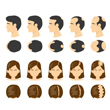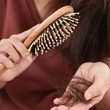Understanding the Diseases That Cause Hair Loss
Introduction 1,2

Your hair is your crowning glory, and seeing strands or chunks of them on your pillow or the bathroom floor can instantly ruin your mood. If you thought only your world had come crashing down due to hair loss, you would be surprised to know that nearly 35 million men and 21 million women suffer from it! When it comes to hair loss, you are surely not alone! There are many physical factors and illnesses that cause hair loss. But, before that– what really is hair loss?
Hair loss, also known as alopecia, is a condition where there is an interruption in the body's normal cycle of hair production. You will be surprised to know that hair loss occurs from all parts of the body but more commonly affects the scalp. On average, your scalp has around 1,00,000 hair strands going through the cycle of growth, rest, fall, and regeneration. If the follicle gets damaged during this life cycle, you will notice your hair fall more quickly than they are regenerated.
Let's delve a bit deeper into understanding diseases that cause hair loss and what you can do to reduce it!
Causes of Hair Loss 3

There are multiple causes, including some illnesses that cause hair loss. Some of them include:
• Heredity
Hair loss can occur in both men and women. While men may suffer from male pattern baldness, women experience female pattern baldness. What's different? Well, they are the same condition called androgenetic alopecia. Irrespective of the term used for hair loss, both are governed by genes that you inherit from your parents. Your genes determine when your hair follicles will begin to shrink and stop growing hair.
• Age
With age, your body begins to slow down, and the story of your hair is no different. Most people start to experience. hair loss as they age. This is primarily because hair growth slows down, and at some point, their hair follicles stop growing hair. This results in thin hair and a receding hairline in both men and women
• Stress
Though the exact mechanism of how stress causes hair loss is not known, current research states that chronic stress increases the levels of certain hormones that may cause hair loss.
• Cancer treatments
Hair loss is very common and apparent in people undergoing cancer treatments like chemotherapy. The drugs used for treating the big 'C' affect the hair follicles during the active phase of treatment. Hair usually regrows after treatment is stopped.
• Hormonal imbalance
Hair loss is very common in women who suffer from hormonal imbalance conditions like PCOS and those who take birth control pills. Hormonal imbalance leads to hair loss and thinning of hair.
• Harsh hair care products
Harsh hair care products and treatments like straightening, perming, etc., can damage your hair follicles temporarily or permanently. This can lead to hair loss.
• Scalp infection
The scalp is the skin of your head and is as susceptible to infections as other parts of your body. Scalp infection can result in dryness or inflamed areas. Any scalp infection can affect the health of your hair follicles, leading to hair loss. In most cases, resolving the infection can stop hair fall.
• Medications
Some medications cause hair fall as a side effect. If you notice excessive hair fall after starting a new medication, speak to your doctor about it.
• Scarring alopecia
This condition is characterized by damage to hair follicles as a result of inflammation. Since the hair follicles are damaged, they cannot regrow hair. There are many conditions and diseases that cause scarring alopecia.
Types of Diseases That Cause Hair Loss 2,3,4,5
Of the many reasons that directly cause hair loss, many people suffer from diseases that lead to hair loss. Some of these include:
• Lupus erythematosus
This autoimmune disease affects the skin. It causes inflammation of the scalp and scarring. Hair does not grow in the scarred area of the scalp, resulting in irreversible hair loss.
• Alopecia areata
Also an autoimmune disease, alopecia is characterized by the body's immune system attacking the hair follicles resulting in hair loss. It also prevents the growth of new hair, resulting in balding.
• Thyroid disorders
The thyroid gland is vital to our existence and governs many body processes, including metabolism. People with thyroid disorders may experience excessive hair loss and thinning. Finding hair in clumps when you comb or brush them may be a sign of thyroid disorder.
• Sexually Transmitted Infections(STIs)
When sexually transmitted infections like syphilis are left untreated, they cause patchy hair loss on the scalp, eyebrows, and other parts of the body.
• Trichotillomania
Also called hair-pulling disorder, trichotillomania is a mental health disorder in which people with the condition keep pulling their hair out. This results in loss of hair on the scalp and the rest of the body. While hair does regrow from the follicles, chronic and repeated hair pulling can damage the follicles and cause permanent hair loss.
• Eating disorders
While people with eating disorders like anorexia and bulimia are already concerned about how they look, little do they realize that their eating disorder also eats away their hair. The growing phase of the hair cycle is prematurely terminated in eating disorders due to starvation, lack of nutrients, gastric abnormalities, and reduced performance of the vital organs.
Ways to Reduce Hair Fall 6
Hair loss can be worrying, and it is normal for people to look for ways to reduce it. Here are some tips to reduce hair fall:
• Use mild, gentle hair care products
One of the first places to begin taking care of your hair and preventing hair loss is switching to mild, gentle hair care products. Since harsh chemicals can damage your hair follicles, use products that do not traumatize or harm them.
• Avoid harsh chemical treatments for your hair
Hair treatments like straightening, smoothening, coloring, etc., use harsh chemicals on your hair. If you are experiencing hair fall, you must stay clear of these treatments and the chemicals used in them.
• Eat a healthy diet
We are what we eat, and this holds for your hair too! Inadequate intake of certain nutrients can result in hair loss. So, if you suspect a nutritional deficiency to be behind your hair loss, you must ensure you are eating a healthy, balanced diet.
• Don't tie your hair behind tightly
Frequently tying your hair behind tightly can result in a type of hair loss called traction alopecia. When this happens frequently, it can result in permanent hair loss. If you are doing this, avoid tying your hair tightly. Let your hair loose and give the follicles a breather and watch your hair loss reduce.
• Avoid using hot irons and perming tools on your hair
Hair curling tools, perming tools, and hot irons heat up your hair and damage your hair follicles, causing hair loss. If you wish to prevent hair loss or reduce it, it may be best to avoid using these tools or undergoing any hair treatment that uses these tools on your hair.
Conclusion
Though there are several causes of hair loss, many of these can be treated to restore your crowning glory. However, the key to managing and treating hair loss is identifying its cause and tackling it at the root. Following a healthy lifestyle and safe haircare products go a long way in keeping your hair on your head! If you suffer from any of the illnesses that cause hair loss, you must see your dermatologist immediately.
Myth Busters HairFall

Androgenetic Alopecia - Everything You Need To Know
Have you been experiencing excessive hair fall over a prolonged period of time? It could be an early sign of androgenetic alopecia. It is a hair loss disorder common in both genders and can lead to progressive thinning and even baldness in some patients if not caught and treated early.

How To Make Hair Grow Faster For Men
A head full of healthy hair is a matter of confidence. Hair has its own mechanism of growing and shedding, and it is when this mechanism is thrown off that growth is hindered. Especially in the case of males, hair growth faces a lot of hiccups that can easily be managed.

Female Pattern Baldness - Causes & Treatments
Have you suddenly noticed an increase in the number of hair strands on your pillow in the morning? Or is your ponytail getting thinner by day? Well, you might be suffering from female pattern baldness. While that does sound scary, identifying it early on is key to treating this condition effectively. So keep reading to know what this is, how you can identify it, and most importantly, what treatments you can avail of to get your beautiful lustrous hair back.

What Are The Reasons For Hairfall?
Almost everyone experiences some amount of hair thinning over the years. Shedding around 50 to 100 single strands of hair per day is considered normal. However, losing more than 150 strands a day, experiencing sudden thinning, or developing circular bald patches on your scalp are reasons for concern. Hair loss occurs when new hair doesn’t grow fast enough to replace the amount of hair you lose daily. Hair can fall due to various reasons, with hereditary hair loss and poor nutrition being the most common hair fall reasons.

Expert Approved Tips For Hair Growth
What can be more debilitating than seeing hundreds of hair strands shedding from your scalp every time you brush your hair? Also, excessive molting occurs during seasonal changes that can be very stressful for you. Although it’s okay to lose between 50-100 strands every day, according to the American Academy of Dermatology, the problem occurs when you start shedding more than normal. But that doesn’t mean you have to feel helpless as there are ways to grow your hair back. Even if you are coping with baldness or alopecia, certain hair growth tips from dermatologists can come to your rescue. Read on to discover how these tips can be your savior when abnormal hair fall problems are in sight.
Trending Videos
+ 6 Sources
'LMRC - GGI-CO-A2-DMA-300001252-300001252-WM-L21-704'
© 2021 Dr. Reddy’s Laboratories Ltd. All rights reserved.